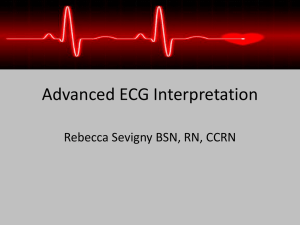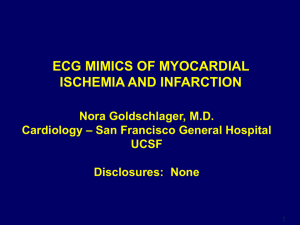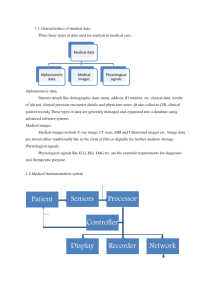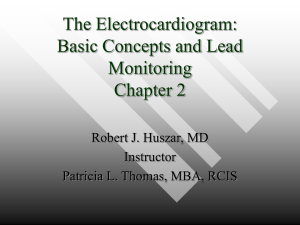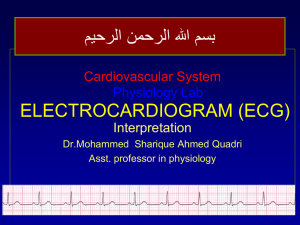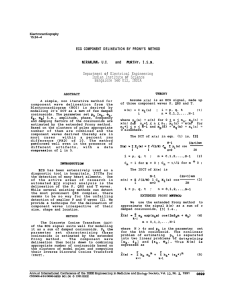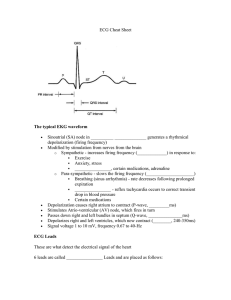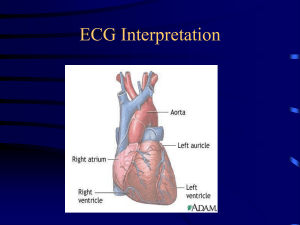ECG Review: The Basics
advertisement
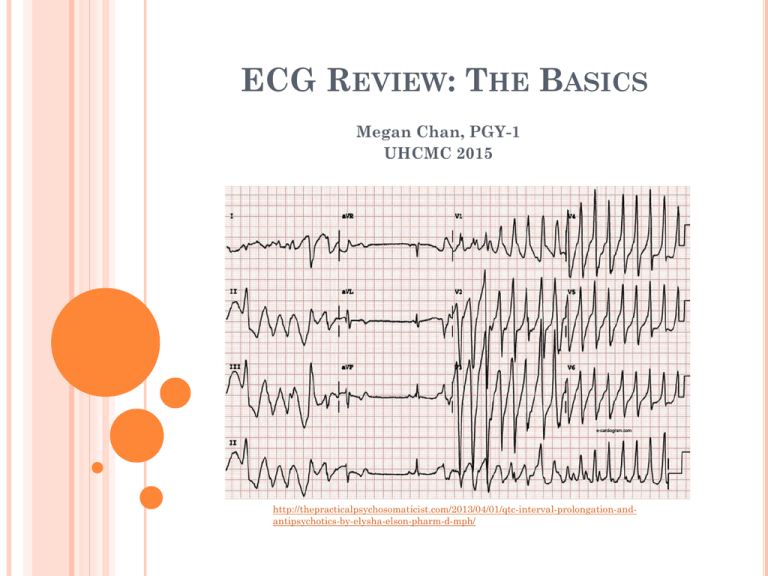
ECG REVIEW: THE BASICS Megan Chan, PGY-1 UHCMC 2015 http://thepracticalpsychosomaticist.com/2013/04/01/qtc-interval-prolongation-andantipsychotics-by-elysha-elson-pharm-d-mph/ THE BASICS http://flylib.com/books/en/2.569.1.27/1/ THE ECG UNIT http://cal.vet.upenn.edu/projects/lgcardiac/ecg_tutorial/printerval.htm THE SYSTEMATIC PROCESS Rate 300/(# large boxes between R—R interval) 300-150-100-75-60-50 Rhythm Regular vs irregular Sinus rhythm? P before every QRS (easiest to see in leads II and V1) Positive p wave in I & II; negative p in aVR Axis Normal axis? Left deviation? Positive QRS sum in I and II (or aVF ) Up in I, down in II Right deviation? Down in I, up/down in II THE SYSTEMATIC PROCESS CONT. Intervals PR interval: normal 120-200ms (3-5 small boxes) Short PR interval = WPW Long PR interval = heart block QRS complex: normal <120ms (≤ 3 small boxes) Long QRS: conduction delays, hyperkalemia, ventricular rhythm QT interval: normal ≤ 430 in men, ≤ 450 in females (less than R—R/2) Long QT: MI, myocarditis, hypocalcemia, hypothyroidism, subarachnoid hemorrhage, drugs—sotolol, amiodarone, hereditary THE SYSTEMATIC PROCESS CONT. Conduction Abnormalities AV blocks RBBB LBBB IVCD (interventricular conduction delay) Left Anterior Fascicular Block Left Posterior Fascicular Block http://healthybeatinghearts.blogsp ot.com/2011/01/first-week-withnew-pacemaker.html http://www.zuniv.net/physiology/book/images/11-13.jpg http://dualibra.com/wpcontent/uploads/2012/04/037800~1/Part%209.%20Disorders%20of%20the %20Cardiovascular%20System/Section%202.%20Diagnosis%20of%20Car diovascular%20Disorders/221.htm http://www.emedu.org/ecg/crapsanyallans.php HEMI BLOCKS = LEFT FASCICULAR BLOCKS http://www.usfca.edu/fac-staff/ritter/Image74.gif LAFB LPFB http://aliem.com/wp-content/uploads/2013/08/LAFB.png http://cdn.lifeinthefastlane.com/wpcontent/uploads/2011/02/avhisbb.jpg http://aliem.com/wp-content/uploads/2013/08/LPFB.png HYPERTROPHY http://dualibra.com/wpcontent/uploads/2012/04/037800~1/Part%209.%20Disorders%20of%20the %20Cardiovascular%20System/Section%202.%20Diagnosis%20of%20Car diovascular%20Disorders/221.htm THE SYSTEMATIC PROCESS CONT. Chamber size RAE LAE • Tall P > 2.5 • P> 120ms mm in lead II • Diphasic p • Large diphasic with P with large downward initial phase terminal in V1 phase > 1mm wide and 1mm deep in V1 • M-shaped P in I, II, or aVL RVH LVH • R in aVR > 5mm (or R>Q) • R in V1 > 7mm • qR in V1 • R in V1 + S in V5/V6 > 10mm • Deep S in V5/V6 > 7mm • R in aVL > 11mm • R in V5/V6 + S in V1/V2 > 35mm • R in I + S in III > 25 mm • R in aVF > 20mm • S in aVR > 14mm THE SYSTEMATIC PROCESS CONT. Ischemia What ECG changes do you expect to see? Hyperacute T waves Inverted T waves ST segment elevation Q waves ST depressions = ??? Subendocardial ischemia ST elevations = ??? Transmural ischemia What are Pathologic Q waves? 1 small box wide and/or >5mm or 1/3 of R wave deep Other changes: Old septal infarct: No R waves in V1-V3 Old lateral infarct: No R wave progression in V4-V6 RV infarct: ST elevation in V4 & V5 with right sided EKG THE SYSTEMATIC PROCESS CONT. Everything Else Pericardial Effusion Pericarditis Low voltage (R waves < 5mm in limb leads, <10mm in precordial leads) Diffuse ST elevations and PR depressions Pulmonary Embolism “S1Q3T3”:S wave in I, Q wave in III, T wave inversion in III Location Leads Occluded Vessel Anterior V2-V4 LAD Anteroseptal V1-V4 LAD Anterolateral V1-V6, I, aVL LAD, diagonal Lateral V5-V6, I, aVL Circumflex, diagonal Inferior II, III, aVF RCA, circumflex Posterior Tall R in V1-V3, ST depression in V1-V2 RCA http://www.edoctoronline.com/media/19 /photos_245a975b-66ad-4f7e-86d882d3ca7d0120.jpg http://dotwordpressdotcom.wordpress.com/med-school/clinical-skills/ecgs/ THE DR. ORTIZ METHOD 4 step method to interpreting 80% of ECGs in 1 minute What are the most important ECG leads? II— best axis, dx inferior wall MI, most studied V1—best p wave, dx anterior wall MI & RBBB V5—dx lateral wall MI, LBBB, & LVH What 2 leads are best for determining axis? I & II 100% sensitive & specific w/ zero false + Normal axis is -30 to 90 aVF was used > 100 years ago Special thanks to Dr. Jose Ortiz! THE DR. ORTIZ METHOD Step 1: Demographics Verifying pt name and calibration of ECG Step 2: Two second look at lead II Regularity of the tracing. Any funny beats? P waves Upright sinus “M” shape LAE Mountain peaks RAE Axis: QRS positive 50% chance of normal axis Intervals Normal QRS <3 boxes >3 boxes BBB Q waves –75% risk for inferior MI THE DR. ORTIZ METHOD Step 3: Study three things about the QRS Axis: normal vs L deviation vs R deviation Confirm suspected axis by looking at lead I Width: normal vs RBBB vs LBBB > 3 boxes wide = abnormal Look at V1 If RSR’ then RBBB; If large S then LBBB. Height: normal vs low voltage vs LVH Remember “14-12-35” for LVH Lead I: R > 14 Lead aVL: R > 12 S in V1 + R in V5/V6 > 35 THE DR. ORTIZ METHOD Step 4: Rate, ST segments, T waves, Infarcts Anterior/Septal infarct: V1-V4 Inferior infarct: II, III, aVF Lateral infarct: aVL, I, V5, V6 DRAW A NORMAL ECG http://www.lysosomalstorageresearch.ca/Fabry_eClinic/electrocardiography-ecg.html HOW TO DRAW A NORMAL ECG aVR I Same as aVR but T & P waves can be + or – Same as II Inverted II aVL II V4 V1 V2 Similar to V3 but less QRS voltage Similar to V3 with smaller S, taller R V5 Similar to V3 with larger S, smaller R Similar to V4 with smaller S, taller R (R wave progression) aVF III Same as II V3 V6 Same as II Same as II Biphasic QRS REFERNCES Agabegi SS, Agabegi ED. Step up to Medicine, 3rd ed. 2013. Lippincott Williams & Wilkins. Philadelphia, PA. Gomella LG, Haist SA. Basic EKG reading. In: Clinician’s Pocket Reference. McGraw-Hill; 2007. http://flylib.com/books/en/2.569.1.27/1/. Accessed Nov 18, 2014. Longo DL, Fauci AS, Kasper DL, et al. Electrocardiography. In: Harrison’s Principles of Internal Medicine, 18th ed. 2012. McGraw Hill. New York, NY. University of Illinois at Chicago. Online ICU Guidebook. 2013. http://chicago.medicine.uic.edu/UserFiles/Servers/Ser ver_442934/Image/1.1/residentguides/final/icuguidebo ok.pdf. Accessed December 1, 2014.

